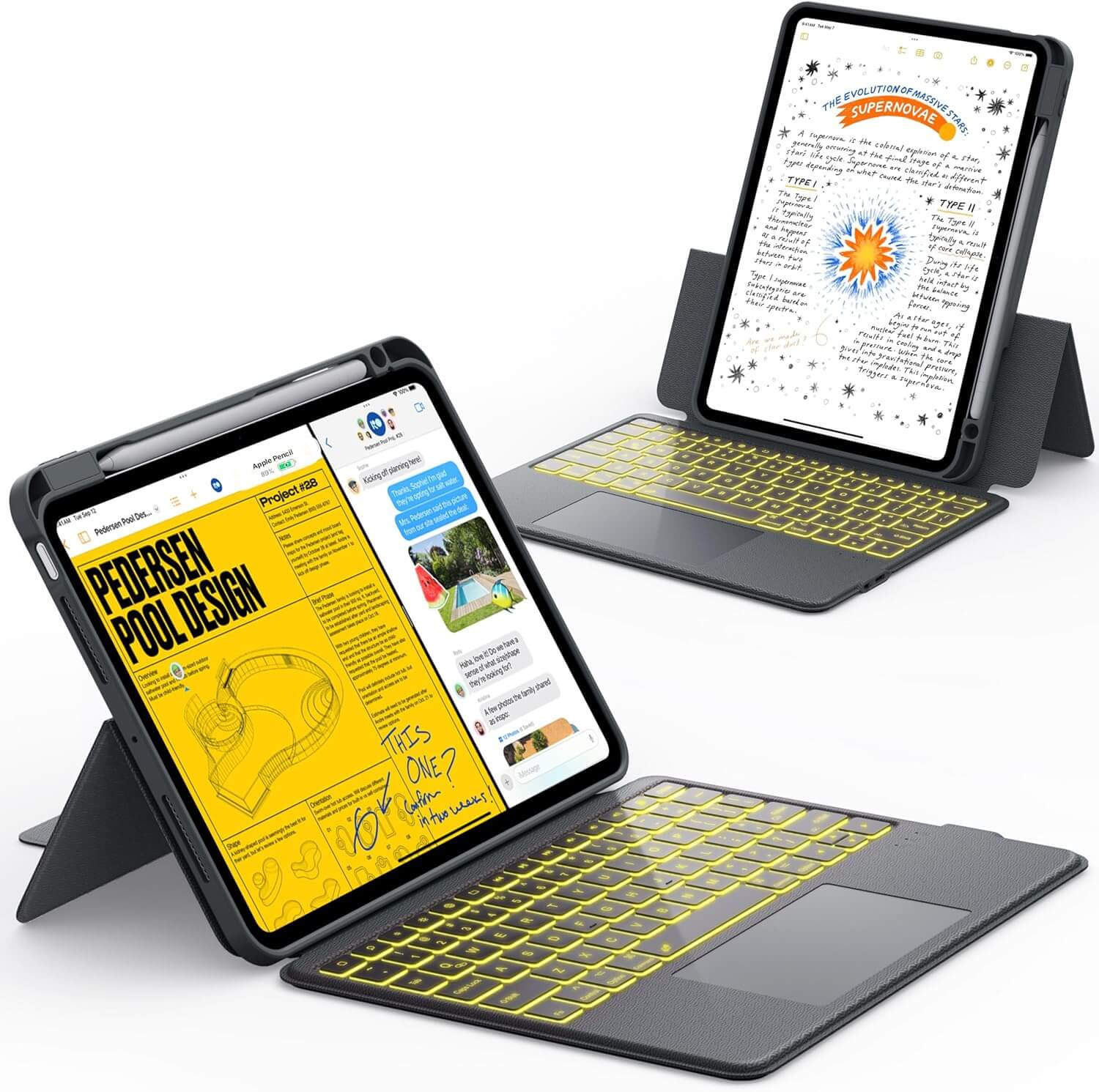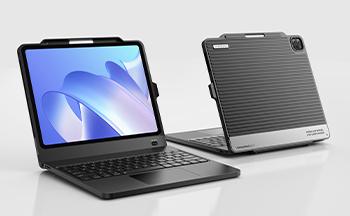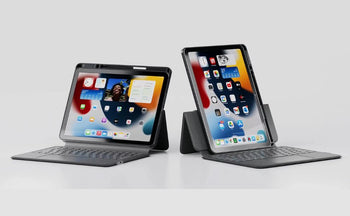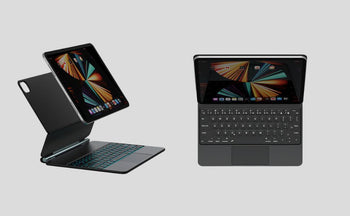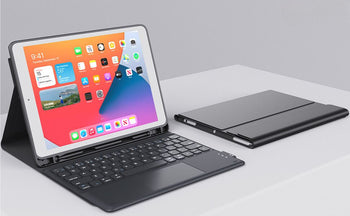Choosing between an iPad Pro and MacBook Air can be tricky. Both Apple devices are awesome but serve different needs.
The iPad Pro gives you a touch screen and Apple Pencil support, making it great for drawing and note-taking. It's super portable at less than a pound (for the 11-inch model), which beats the MacBook Air's weight.
The MacBook Air offers better value for most users with its longer battery life (up to 18 hours compared to iPad Pro's 10 hours) and more storage options (8GB, 16GB, or 24GB).
You might love using the iPad Pro with its Magic Keyboard and Pencil—many find it an enjoyable experience. But if you need to run desktop apps or do heavy multitasking, the MacBook Air's laptop form factor gives you more flexibility.
Your choice depends on whether you value touchscreen creativity or traditional laptop productivity more.
iPad Pro vs MacBook Air: Key Differences at a Glance
|
Category |
iPad Pro (M4) |
MacBook Air (M3) |
|
Design & Portability |
- Lighter (11": 0.98 lbs; 13": 1.28 lbs) - Touchscreen + Apple Pencil support - USB-C with Thunderbolt/USB 4 |
- Heavier (13.6": 2.7 lbs; 15": 3.3 lbs) - Traditional laptop design - MagSafe 3 port + 2 Thunderbolt/USB 4 ports + headphone jack |
|
Display |
- 11" or 13" Tandem OLED Ultra Retina XDR - ProMotion (120Hz) - 2752 x 2064 pixels (13") |
- 13.6" or 15" Liquid Retina Display - 60Hz refresh rate - 500 nits brightness - 2560 x 1664 pixels (13.6") |
|
Performance |
- M4 chip (9-10 CPU cores, 10 GPU cores) - Better for AI/graphics tasks |
- M3 chip (8 CPU cores, 10 GPU cores) - Better for multitasking |
|
Memory |
8GB-16GB unified memory |
8GB-24GB unified memory |
|
Battery Life |
~10 hours (normal use) |
~18 hours (normal use) |
|
Storage |
256GB-2TB (no expandable storage) |
256GB-2TB (no expandable storage) |
|
Software |
iPadOS (touch-first, mobile apps) |
macOS (full desktop apps, better multitasking) |
|
Keyboard/Typing |
Requires Magic Keyboard ($299 extra) |
Built-in keyboard (no extra cost) |
|
Camera |
- 12MP wide (4K, ProRes) - 12MP ultra-wide landscape front camera |
1080p FaceTime HD camera with computational video |
|
Biometrics |
Face ID |
Touch ID |
|
Connectivity |
- USB-C with Thunderbolt/USB 4 - Wi-Fi 6E, 5G (cellular models) |
- MagSafe 3 charging - 2 Thunderbolt/USB 4 ports - 3.5mm headphone jack |
|
Creativity |
Best for drawing/note-taking (Apple Pencil) - Procreate, LumaFusion |
Limited to mouse/trackpad input - Full Adobe Suite, Final Cut Pro |
|
Productivity |
Good for light work (with accessories) |
Better for heavy multitasking (coding, spreadsheets) |
|
Colors |
Silver, Space Black |
Starlight, Midnight, Space Gray, Silver |
|
Price (Starting) |
$999 + $299 (keyboard) + $129 (Pencil) |
$999 (base model) |
|
Best For |
Artists, students, media consumption, portability |
Professionals, coders, long typing sessions |
Comparison & Difference of iPad Pro vs MacBook Air

When choosing between an iPad Pro and MacBook Air, understanding their core differences helps you make the right decision for your needs and budget.
Design and Portability
The iPad Pro wins on portability, weighing under a pound (11-inch model). The MacBook Air is heavier but includes a built-in keyboard. The iPad feels more natural for reading, drawing, and browsing, while the MacBook sits better on your lap for typing.
The iPad Pro offers a touchscreen experience that feels immediate and intuitive. The MacBook Air provides more connection options with its extra ports, making it easier to work with external devices.
Price Comparison
The real cost comparison:
- MacBook Air: $999 (everything included)
- iPad Pro: $999 + $299 (keyboard) + $129 (pencil) = $1,427 total
The iPad Pro's "hidden costs" often surprise buyers who want laptop-like functionality. Consider what you're really getting for your money based on how you'll use the device daily.
Ready to unlock your iPad's full potential? Read our guide: 5 Pro Methods to Connect iPad & iPad Pro to External Monitors, and transform how you work and create.
Target User Profile
The MacBook Air feels right at home for:
- Writing long documents with minimal hand strain
- Jumping between multiple apps and windows
- Managing files and folders with precision
- Coding or working with specialized software
The iPad Pro creates a better experience for:
- Drawing, sketching, and precision editing
- Reading and annotating documents
- Enjoying videos and games with superior display
- Working in tight spaces like planes or coffee shops
The MacBook Air's 18-hour battery life means you can work all day without worry, while the iPad Pro's 10-hour limit might leave you searching for outlets during long days.
Performance Feel
Both devices feel snappy for everyday tasks. The iPad Pro's M4 chip excels at graphics work - you'll notice smoother video editing and more responsive drawing.
The MacBook Air handles multiple open applications more gracefully thanks to its multitasking-friendly operating system.
Display Experience
The iPad Pro's screen simply looks better - colors pop more, blacks are deeper, and everything moves more smoothly thanks to the 120Hz refresh rate. Touch and pencil input make interacting with content feel natural.
The MacBook Air's display is still excellent but exists in a more traditional computing environment where you'll interact through keyboard and trackpad.
Working Style
The iPad Pro runs iPadOS, which prioritizes one or two apps at a time with a touch-first approach. This creates a more focused experience but can feel limiting when managing complex workflows.
The MacBook Air runs macOS, offering a familiar desktop environment where you can arrange windows however you like. This flexibility helps when referencing multiple sources or using several tools simultaneously.
Choose based on how you prefer to work rather than just specifications. The best device is the one that feels most natural for your daily tasks.
Software Experience

The iPad Pro and MacBook Air offer very different software experiences that determine how you'll interact with your device. These differences affect everything from how you get work done to which apps you can use.
iPadOS vs macOS Capabilities
iPadOS is touch-first and designed for the iPad Pro's tablet form factor. You can tap, swipe, and use Apple Pencil directly on screen. It's super intuitive if you're used to smartphones.
macOS on the MacBook Air is more traditional with its cursor-based interface. It gives you more powerful file management with a proper desktop and Finder. You'll get full desktop-class apps rather than mobile versions.
iPadOS has come a long way with features like Stage Manager, but it still has limitations. You can't run multiple instances of the same app easily or use external displays as freely as on macOS.
The MacBook Air running macOS feels more like a complete computer system with fewer restrictions on what you can do with files and folders.
App Ecosystem
The App Store on iPadOS has tons of apps designed for touch. These include creative apps like Procreate that don't exist on Mac. Many iPad apps are also cheaper than their Mac counterparts.
MacBook Air, however, can run nearly any Mac software created over decades. This includes professional tools like Final Cut Pro and the full Adobe Creative Suite with all features intact.
Web browsing is another difference. Safari on iPadOS still loads mobile versions of websites sometimes, while macOS gives you the complete desktop experience every time.
Game selection differs too. iPad Pro has many touch-optimized games, while MacBook Air can run more demanding PC titles but lacks touch controls.
Multitasking Workflow
Working with multiple apps simultaneously is where these platforms really differ. macOS lets you freely resize and position windows anywhere you want. You can see many apps at once exactly how you like them.
iPadOS uses Split View and Slide Over for multitasking. These are more limited but work well with touch. The newer Stage Manager feature makes iPad multitasking more Mac-like, but it's still not as flexible.
File transfers between apps on macOS are simple drag-and-drop operations. On iPadOS, the process often requires more steps using the Share menu.
The MacBook Air also better supports multiple displays. You can extend your workspace across screens, while iPad Pro has more limitations with external displays despite recent improvements.
Productivity Features

When choosing between an iPad Pro and MacBook Air, productivity features can make a huge difference in your daily workflow. Both devices offer unique tools that might fit your work style better.
Keyboard and Typing Experience
The MacBook Air comes with a built-in keyboard that many users love. It has good key travel and a large trackpad that makes navigation easy. You don't need to buy anything extra to start typing right away.
For the iPad Pro, you'll need to get the keyboard separately. This adds to the cost, but it gives you a decent typing experience, a built-in trackpad, and protection for your iPad.
The keyboard turns your iPad into a laptop-like device with a floating design so you can adjust viewing angles. The trackpad is smaller than the MacBook's but still works well for gestures.
Some people find typing on the MacBook more comfortable for long sessions. The iPad setup is great if you need to switch between typing and tablet modes quickly.
Wondering if you can ditch your laptop completely? Our guide, Can the iPad Pro replace your laptop? gives you the honest answer based on real user experiences.
Apple Pencil Support
This is where the iPad Pro absolutely shines! The MacBook Air has no pen support at all, while the iPad Pro works with the Apple Pencil for amazing creative control.
With Apple Pencil, you can:
- Take handwritten notes
- Draw with pressure sensitivity
- Mark up documents and screenshots
- Edit photos with precision
The newest Apple Pencil has super low latency, making it feel just like writing on paper. This is perfect for artists, designers, and anyone who likes to sketch out ideas.
For students and professionals who take lots of notes, this feature alone might make the iPad Pro worth choosing. You can quickly switch between typing and writing by hand.
External Display Compatibility
The MacBook Air wins big here. You can connect it to external displays easily, and the operating system handles multiple screens very well. This lets you spread out your work and multitask better.
The iPad Pro's external display support has improved with newer software versions. Now you can connect to larger screens, use multiple windows side by side, and resize apps more freely.
But there are still limitations. The MacBook gives you more flexibility with window management and supports more monitor configurations.
For serious productivity setups with multiple screens, the MacBook Air provides a more desktop-like experience.
Content Creation
CHESONA Backstand Keyboard Case for iPad Pro 13'' (M4) 2024
Both the iPad Pro and MacBook Air offer powerful tools for creating various types of content. Each device has strengths and weaknesses depending on what kind of creative work you're doing.
Photo and Video Editing
The iPad Pro shines for on-the-go editing with its touchscreen and pencil support. The M4 chip handles 4K video editing smoothly, and the ProMotion display shows your work in vivid detail.
The MacBook Air offers a more traditional but powerful editing experience. You'll appreciate the better file management system when working with large media libraries.
For photos, both devices run editing software well, but the MacBook's larger screen gives you more workspace.
Digital Art and Design
The iPad Pro absolutely dominates in this category. Drawing directly on the screen feels natural and responsive.
The pressure sensitivity and tilt recognition make creating digital art feel much more intuitive than using a drawing tablet with a MacBook.
For graphic design, the iPad Pro works great for concept work and illustrations with professional-grade vector tools.
The MacBook Air still handles design software well, making it better for page layout and complex projects that need precise mouse control.
Audio Production
The MacBook Air has a clear advantage for serious audio work. You get access to professional audio workstations that have more features than iPad alternatives.
The MacBook's multiple ports make it easier to connect audio interfaces, controllers, and other music gear. You can also manage larger projects with many tracks.
The iPad Pro works well for mobile recording and beat-making. The touchscreen makes adjusting parameters and playing virtual instruments fun and intuitive.
For podcasters, the MacBook Air offers better tools for editing lengthy recordings and managing large audio files.
Entertainment Value

Gaming Performance
The iPad Pro packs serious gaming power with its M4 chip. Touch controls give you a hands-on experience that works great for many mobile games.
The MacBook Air handles many games well too, giving you access to more traditional computer games. The keyboard and trackpad setup feels more familiar if you're used to computer gaming.
Where the iPad shines is with games designed for touch. The MacBook wins when you need mouse precision or want to play more demanding titles.
Media Consumption
When it comes to watching videos, the iPad Pro's display is hard to beat. The bright, vibrant screen with 120Hz refresh rate makes everything look amazing.
The MacBook Air wins the battery life contest by a huge margin - about 18 hours compared to the iPad Pro's 10 hours. You can watch nearly twice as long without charging.
The iPad's form factor lets you hold it like a book or prop it up on your lap. The MacBook's larger screen can be nice for longer viewing sessions, and its speakers generally provide richer sound.
Portability Factor
The iPad Pro is the clear winner for on-the-go entertainment. At under a pound for the 11-inch model, you can easily hold it for hours without fatigue.
You can quickly pull out your iPad while waiting in line or on a crowded train. Its instant-on capability means you're entertaining yourself seconds after deciding to use it.
The MacBook Air is still impressively portable for a laptop but requires a flat surface for comfortable use.
Connectivity
The ways you can connect to other devices might make a big difference in your daily use.
Port Selection
The iPad Pro comes with just one USB-C port, which limits how many things you can plug in at once.
The MacBook Air gives you more options with two USB-C ports. This means you can charge your laptop while still having another port free for connecting a display or other device. It also includes a headphone jack, which the iPad Pro lacks.
If you need to connect multiple devices at once, the MacBook Air has a clear advantage.
Accessory Ecosystem
The iPad Pro's touch screen opens up unique accessory options like the pencil, which is awesome for artists and note-takers.
The MacBook Air works better with traditional computer peripherals and can connect to more types of external displays.
Wireless Capabilities
Both devices offer similar wireless connection options, but there are some differences.
The iPad Pro offers cellular options (for an extra cost), letting you connect to the internet anywhere without Wi-Fi. The MacBook Air doesn't have this option.
For video calls, both have front-facing cameras, but the iPad Pro's camera quality is typically better.
The MacBook Air connects more easily to wireless printers and network drives, which can be trickier on the iPad.
iPad Pro vs MacBook Air: Which Should You Choose?
Pick the iPad Pro if you love drawing, watching movies, or working on the go. Its touch screen and light weight make it fun to use anywhere.
Choose the MacBook Air if you type a lot, need long battery life, or use special work software. Both are amazing - just think about what you do most days!
If you go with the iPad Pro, don't forget to protect your investment. Chesona makes great keyboard cases that can turn your iPad into a mini-laptop while keeping it safe. Their cases include backlit keyboards and track
Frequently Asked Questions
Can the iPad Pro truly replace a MacBook Air for professional video editing tasks?
The iPad Pro can handle basic to intermediate video editing with apps like LumaFusion and iMovie. For lighter projects, it works great.
But for serious professional video work, the MacBook Air still has advantages. The Air runs full desktop editing software like Final Cut Pro and Adobe Premiere without limitations.
The iPad's touch interface makes some editing tasks feel more natural. But the MacBook's larger RAM, better file management, and more powerful multitasking give it the edge for complex projects.
Are there specific tasks that the MacBook Air can handle that the iPad Pro can't?
Yes! The MacBook Air runs full desktop software that iPadOS can't. You'll have access to professional development tools, coding environments, and specialized software.
Web browsing is also different. Some websites still don't work perfectly on iPad, especially those requiring complex interactions or plugins.
External device support is better on MacBook. You can connect multiple displays and use a wider range of peripherals without workarounds.
For a tech-savvy individual, which device is a smarter choice: the iPad Pro or the MacBook Air?
If you're into creating digital art, taking notes by hand, or want ultimate portability, the iPad Pro shines. The Apple Pencil and touch interface are game-changers for creative work.
For coding, complex document creation, or heavy multitasking, the MacBook Air makes more sense. Having a full desktop operating system gives you more flexibility.
Your existing tech ecosystem matters too. If you already have an iPhone and Apple Watch, an iPad might complement them better for certain workflows.
How does the user experience differ between working on an iPad Pro versus a MacBook Air?
The iPad Pro gives you a more tactile, direct experience. You can touch, draw, and interact with content naturally.
It feels more like working with physical objects.
The MacBook Air provides a traditional computing experience with a keyboard and trackpad. Window management is more flexible, letting you arrange multiple apps exactly how you want.
Battery life is excellent on both, but the iPad Pro typically lasts longer.
The iPad is also more comfortable to use in bed, on the couch, or standing up in ways the MacBook isn't designed for.
